
It helped keep workers on the payroll and paying taxes.įurther, investors who supply much of the tax revenue in states like New York and California, which announced a $15 billion surplus in January, had a good year because of the soaring stock market. Last year’s relief spending helped by sending money directly to governments, businesses and individuals. But that might run afoul of a provision in the relief package that bars the money from being used to pay for tax cuts.Īround the country, it turns out that the state budget picture generally isn’t as bleak as it was expected to be. The Republicans who control state government in Georgia are working on plans to cut taxes - something being pursued in other GOP-run states, including Arizona and Iowa. “It’s a slap in the face for my fellow Georgians.” “Instead of using the bipartisan blueprint of previous federal coronavirus relief bills, this legislation is literally a wish list for California and New York,” said Georgia Gov. They also object to a formula that distributes more money per capita to states with higher unemployment rates, which they see as penalizing them for keeping more of their economies open through the pandemic. Republican governors are arguing that the economy is already in recovery and that all the spending will eventually need to be repaid by the taxpayers. The new package gives states much more flexibility. While the behemoth CARES Act adopted last March included $150 billion for state, local and tribal governments, that help was restricted mostly to direct pandemic-related costs. In New Mexico, officials expect to use $600 million to pay off debts to the state’s unemployment fund - a move that would prevent a spike in payroll taxes for businesses - and still have more than $1 billion for projects such as economic development grants, road improvements and others still to be determined. In Democrat-controlled California, GOP-held Idaho, and Vermont, with a Republican governor and Democratic legislative majority, priorities include drinking water and rural broadband projects. That’s like the difference between watching a program on a tube television and an HD flatscreen monitor.Even Republican governors who have argued against the plan are drawing up ambitious plans similar to what’s on the wish lists of Democratic lawmakers and governors. That’s five times the resolution of SDO images, or any previous space telescope for that matter.

These mirrors allowed Hi-C to image a section of the Sun’s corona in extreme ultraviolet light with a resolution of 0.1 arcsec/pixel, distinguishing features as small as 135 miles (217 km) across. Launched aboard a 58-foot-tall (17 meter) Black Brant sounding rocket, Hi-C was equipped with exceptionally well-made mirrors - some of the finest ever made, according to the mission report.


These images of the dynamic million-degree region of the Sun’s atmosphere will provide scientists with more information on the complex activity found near the Sun’s surface and how it affects space weather throughout the Solar System. NASA’s High Resolution Coronal Imager (Hi-C) mission, launched Wednesday, July 11 from White Sands Missile Range in New Mexico, successfully returned (as promised!) the highest-resolution images of the Sun’s corona ever acquired.


 0 kommentar(er)
0 kommentar(er)
